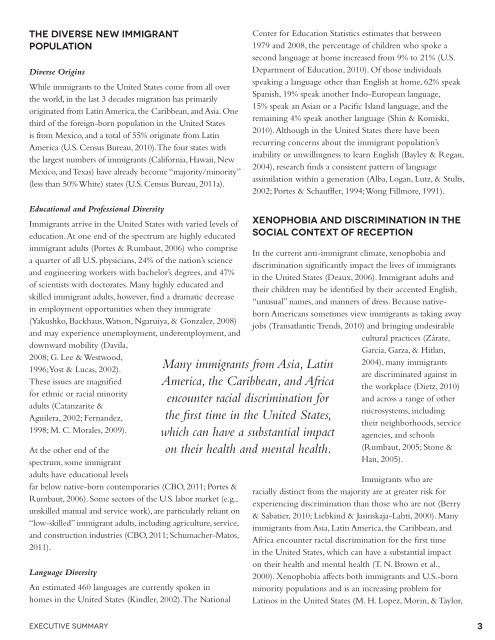Crossroads: The Psychology of Immigration in the New Century
Crossroads: The Psychology of Immigration in the New Century
Crossroads: The Psychology of Immigration in the New Century
Create successful ePaper yourself
Turn your PDF publications into a flip-book with our unique Google optimized e-Paper software.
<strong>The</strong> diverse <strong>New</strong> Immigrant<br />
Population<br />
Diverse Orig<strong>in</strong>s<br />
While immigrants to <strong>the</strong> United States come from all over<br />
<strong>the</strong> world, <strong>in</strong> <strong>the</strong> last 3 decades migration has primarily<br />
orig<strong>in</strong>ated from Lat<strong>in</strong> America, <strong>the</strong> Caribbean, and Asia. One<br />
third <strong>of</strong> <strong>the</strong> foreign-born population <strong>in</strong> <strong>the</strong> United States<br />
is from Mexico, and a total <strong>of</strong> 55% orig<strong>in</strong>ate from Lat<strong>in</strong><br />
America (U.S. Census Bureau, 2010). <strong>The</strong> four states with<br />
<strong>the</strong> largest numbers <strong>of</strong> immigrants (California, Hawaii, <strong>New</strong><br />
Mexico, and Texas) have already become “majority/m<strong>in</strong>ority”<br />
(less than 50% White) states (U.S. Census Bureau, 2011a).<br />
Educational and Pr<strong>of</strong>essional Diversity<br />
Immigrants arrive <strong>in</strong> <strong>the</strong> United States with varied levels <strong>of</strong><br />
education. At one end <strong>of</strong> <strong>the</strong> spectrum are highly educated<br />
immigrant adults (Portes & Rumbaut, 2006) who comprise<br />
a quarter <strong>of</strong> all U.S. physicians, 24% <strong>of</strong> <strong>the</strong> nation’s science<br />
and eng<strong>in</strong>eer<strong>in</strong>g workers with bachelor’s degrees, and 47%<br />
<strong>of</strong> scientists with doctorates. Many highly educated and<br />
skilled immigrant adults, however, f<strong>in</strong>d a dramatic decrease<br />
<strong>in</strong> employment opportunities when <strong>the</strong>y immigrate<br />
(Yakushko, Backhaus, Watson, Ngaruiya, & Gonzalez, 2008)<br />
and may experience unemployment, underemployment, and<br />
downward mobility (Davila,<br />
2008; G. Lee & Westwood,<br />
1996; Yost & Lucas, 2002).<br />
<strong>The</strong>se issues are magnified<br />
for ethnic or racial m<strong>in</strong>ority<br />
adults (Catanzarite &<br />
Aguilera, 2002; Fernandez,<br />
1998; M. C. Morales, 2009).<br />
At <strong>the</strong> o<strong>the</strong>r end <strong>of</strong> <strong>the</strong><br />
spectrum, some immigrant<br />
adults have educational levels<br />
far below native-born contemporaries (CBO, 2011; Portes &<br />
Rumbaut, 2006). Some sectors <strong>of</strong> <strong>the</strong> U.S. labor market (e.g.,<br />
unskilled manual and service work), are particularly reliant on<br />
“low-skilled” immigrant adults, <strong>in</strong>clud<strong>in</strong>g agriculture, service,<br />
and construction <strong>in</strong>dustries (CBO, 2011; Schumacher-Matos,<br />
2011).<br />
Language Diversity<br />
An estimated 460 languages are currently spoken <strong>in</strong><br />
homes <strong>in</strong> <strong>the</strong> United States (K<strong>in</strong>dler, 2002). <strong>The</strong> National<br />
EXECUTIVE SUMMARY<br />
Many immigrants from Asia, Lat<strong>in</strong><br />
America, <strong>the</strong> Caribbean, and Africa<br />
encounter racial discrim<strong>in</strong>ation for<br />
<strong>the</strong> first time <strong>in</strong> <strong>the</strong> United States,<br />
which can have a substantial impact<br />
on <strong>the</strong>ir health and mental health.<br />
Center for Education Statistics estimates that between<br />
1979 and 2008, <strong>the</strong> percentage <strong>of</strong> children who spoke a<br />
second language at home <strong>in</strong>creased from 9% to 21% (U.S.<br />
Department <strong>of</strong> Education, 2010). Of those <strong>in</strong>dividuals<br />
speak<strong>in</strong>g a language o<strong>the</strong>r than English at home, 62% speak<br />
Spanish, 19% speak ano<strong>the</strong>r Indo-European language,<br />
15% speak an Asian or a Pacific Island language, and <strong>the</strong><br />
rema<strong>in</strong><strong>in</strong>g 4% speak ano<strong>the</strong>r language (Sh<strong>in</strong> & Komiski,<br />
2010). Although <strong>in</strong> <strong>the</strong> United States <strong>the</strong>re have been<br />
recurr<strong>in</strong>g concerns about <strong>the</strong> immigrant population’s<br />
<strong>in</strong>ability or unwill<strong>in</strong>gness to learn English (Bayley & Regan,<br />
2004), research f<strong>in</strong>ds a consistent pattern <strong>of</strong> language<br />
assimilation with<strong>in</strong> a generation (Alba, Logan, Lutz, & Stults,<br />
2002; Portes & Schauffler, 1994; Wong Fillmore, 1991).<br />
Xenophobia and discrim<strong>in</strong>ation <strong>in</strong> <strong>the</strong><br />
social Context <strong>of</strong> reception<br />
In <strong>the</strong> current anti-immigrant climate, xenophobia and<br />
discrim<strong>in</strong>ation significantly impact <strong>the</strong> lives <strong>of</strong> immigrants<br />
<strong>in</strong> <strong>the</strong> United States (Deaux, 2006). Immigrant adults and<br />
<strong>the</strong>ir children may be identified by <strong>the</strong>ir accented English,<br />
“unusual” names, and manners <strong>of</strong> dress. Because nativeborn<br />
Americans sometimes view immigrants as tak<strong>in</strong>g away<br />
jobs (Transatlantic Trends, 2010) and br<strong>in</strong>g<strong>in</strong>g undesirable<br />
cultural practices (Zárate,<br />
Garcia, Garza, & Hitlan,<br />
2004), many immigrants<br />
are discrim<strong>in</strong>ated aga<strong>in</strong>st <strong>in</strong><br />
<strong>the</strong> workplace (Dietz, 2010)<br />
and across a range <strong>of</strong> o<strong>the</strong>r<br />
microsystems, <strong>in</strong>clud<strong>in</strong>g<br />
<strong>the</strong>ir neighborhoods, service<br />
agencies, and schools<br />
(Rumbaut, 2005; Stone &<br />
Han, 2005).<br />
Immigrants who are<br />
racially dist<strong>in</strong>ct from <strong>the</strong> majority are at greater risk for<br />
experienc<strong>in</strong>g discrim<strong>in</strong>ation than those who are not (Berry<br />
& Sabatier, 2010; Liebk<strong>in</strong>d & Jas<strong>in</strong>skaja-Lahti, 2000). Many<br />
immigrants from Asia, Lat<strong>in</strong> America, <strong>the</strong> Caribbean, and<br />
Africa encounter racial discrim<strong>in</strong>ation for <strong>the</strong> first time<br />
<strong>in</strong> <strong>the</strong> United States, which can have a substantial impact<br />
on <strong>the</strong>ir health and mental health (T. N. Brown et al.,<br />
2000). Xenophobia affects both immigrants and U.S.-born<br />
m<strong>in</strong>ority populations and is an <strong>in</strong>creas<strong>in</strong>g problem for<br />
Lat<strong>in</strong>os <strong>in</strong> <strong>the</strong> United States (M. H. Lopez, Mor<strong>in</strong>, & Taylor,<br />
3
















